Planning to visit Metro Manila as a tourist but don’t know how to get around the city? If you’re looking for a comprehensive guide about how Philippine public transportation works, then this article is for you.
First things first, set your expectations low because getting around Manila is definitely not an easy feat due to the following reasons:
- It is a huge metropolis with poor urban planning. To give an overview, Metro Manila is composed of 16 cities and one municipality with an overall estimated population of 13.5 million according to the 2020 census data from PSA. This swells to more than 15 million during the day since there are people from nearby provinces who work in the metro.
- It has one of the worst traffic situations in the world. According to TomTom’s 2020 traffic index, Manila ranked fourth among the 416 cities surveyed.
- It is not commuter-friendly. Unfortunately, the development of most of Manila’s public transportation infrastructure has been very much car-centric. As a result, most major roads are neither walkable nor bike-friendly.
Nevertheless, using public transport to explore the urban area is an excellent way to know more about Filipino culture and how we live on a daily.
What are the modes of transportation in Manila?
Public transport options in Metro Manila include trains, buses, vans, jeepneys, taxis, tricycles, and ride-hailing services like Grab, Angkas, and Joyride. Generally, your cheapest options would be to take trains, regular buses, and jeepneys for moderate-to-long-distance travel, and tricycles for short-distance travel. Vans and point-to-point buses are a bit more expensive, however, they generally offer more comfort. If your destination is not reachable via mass transport routes, then your only option is to take a taxi or a ride-hailing service.
Metro Manila Train Lines
As of November 2022, there are 5 railway systems that operate in Metro Manila: LRT-1, LRT-2, MRT-3, PNR South Commuter, and PNR North Commuter lines. LRT and MRT lines are both rapid transit, while PNR lines are commuter rails. That means LRT and MRT railcars pass by each station at a higher frequency— typically every 5-10 minutes, while PNR railcars operate on a schedule.
There is no line that operates 24 hours. All trains generally only operate between 4:30 AM and 10 PM, so if you plan to travel beyond that window period, your best option would be to take a taxi or a ride-hailing service.
Fares and Tickets
To ride LRT-1, LRT-2, or MRT-3, you can either buy a Single Journey Ticket or a reloadable Beep Card (with a minimum ₱100 load) at the station. If you plan to use the train more than once, it is practical to use a Beep Card since it offers cheaper fares. It also saves you the hassle of lining up at the counter since it can be reloaded online or via the loading machines.
On the other hand, PNR only uses commuter tickets that can be paid at the stations in cash.

The train fare ranges from ₱13 to ₱28 for MRT-3, ₱11 to ₱30 for LRT-1 and LRT-2, and ₱15 to ₱60 for PNR. The fare matrix for each train line is shown below.
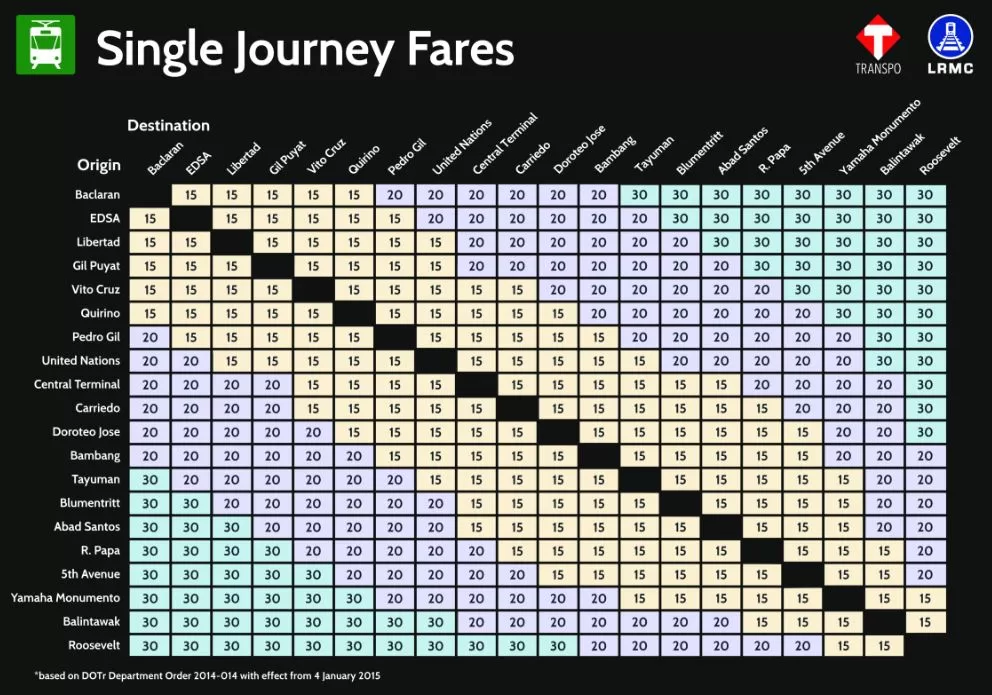
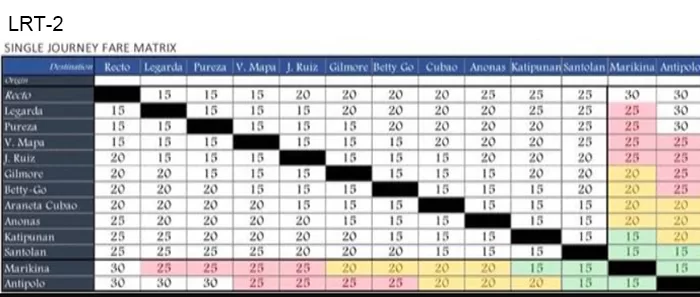
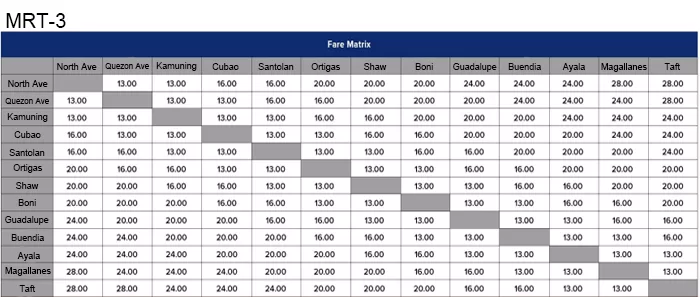
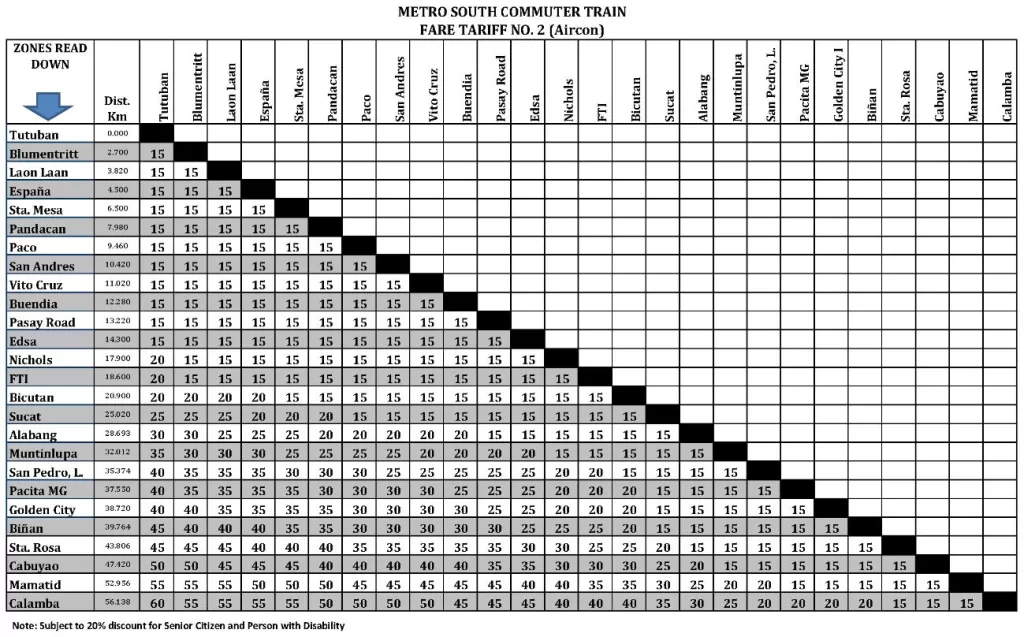
Routes
The map below shows the operational route and stations of each railway line as of November 2022. LRT-1 is represented by the yellow line, LRT-2 by the purple line, MRT-3 by the blue line, and PNR by the red line.
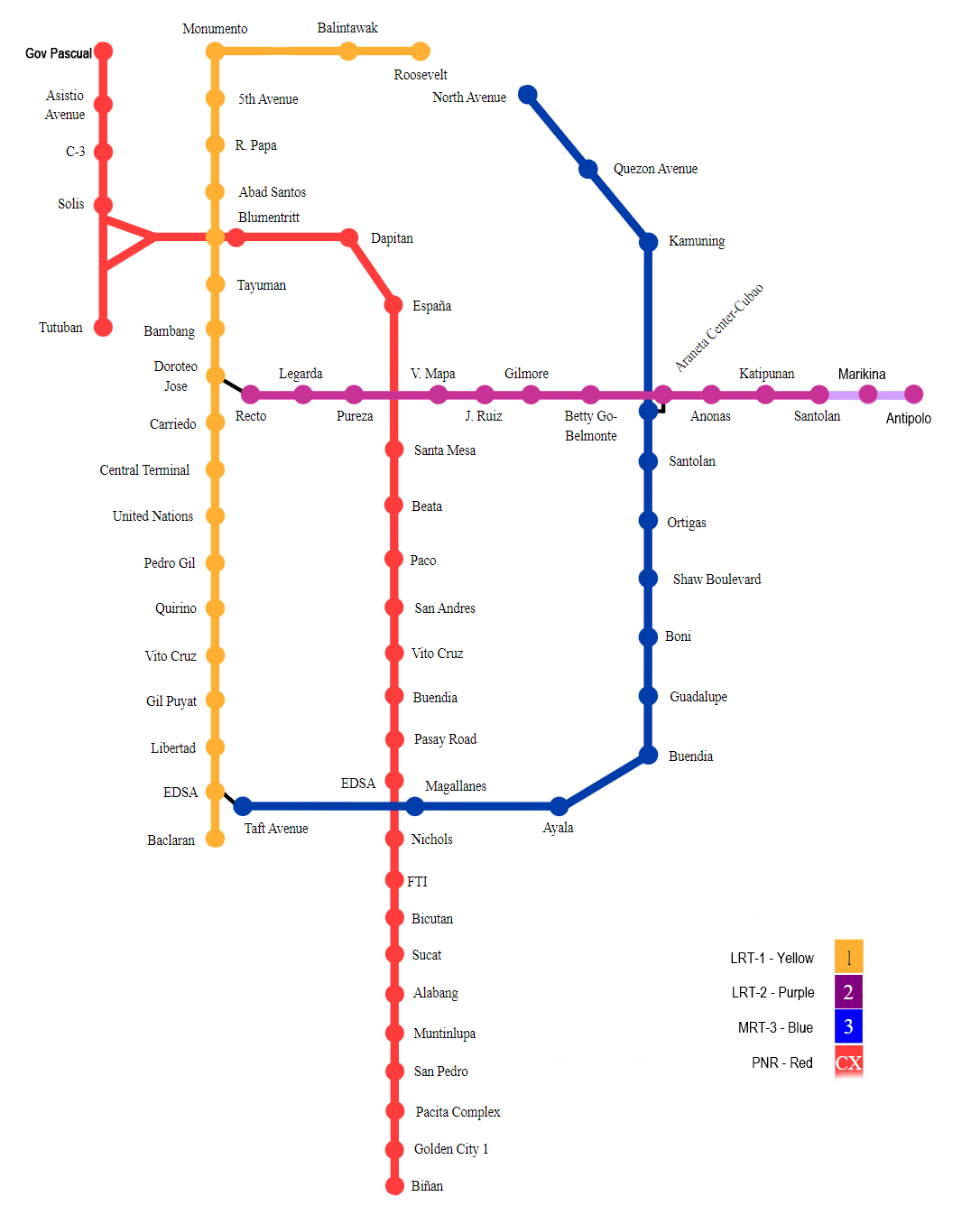
The dots indicate the stations, while the black lines indicate the transfer walkways between the intersecting train lines. LRT-1 and LRT-2 intersect at Doroteo Jose and Recto stations, LRT-1 and MRT-3 at EDSA and Taft Avenue stations, and LRT-2 and MRT-3 at Araneta Center Cubao station.
LRT-1 Stations and Landmarks
Light Rail Transit Line 1, commonly known as LRT-1, is composed of 20 stations, spanning 19.65 kilometers from Baclaran (Parañaque) to Roosevelt (Quezon City). The stations are listed below together with their nearby landmarks.
- Baclaran: Baclaran Market
- EDSA: LRT1-MRT3 transfer footbridge, several motels and hotels
- Libertad: Pasay Public Market, Cartimar Market
- Gil Puyat: Bus Terminals (JAC, Jam, and DLTB Lines)
- Vito Cruz: De La Salle University, St. Scholastica’s College, Rizal Memorial Sports Complex
- Quirino: Manila Zoo, San Andres Market, Malate area
- Pedro Gil: UP Manila, Philippine General Hospital, Robinsons Manila, Philippine Women’s University
- United Nations: Rizal Park, National Museum, NBI, Manila Police Headquarters
- Central Terminal: SM Manila, Intramuros, Civil Service Commission, various universities
- Carriedo: Quiapo Market, Quiapo Church, Quinta Market, Divisoria Market
- Doroteo Jose: LRT1-LRT2 transfer footbridge, Manila City Jail, Manila Grand Opera, Arranque Market
- Bambang: Bambang Market, medical supply stores
- Tayuman: San Lazaro Hospital, Department of Health, Land Transportation Office
- Blumentritt: Chinese General Hospital, SM San Lazaro
- Abad Santos: Ospital ng Tondo, Tondo area
- R. Papa: Manila Chinese Cemetery
- 5th Avenue: Caloocan City Medical Center, Caloocan City Hall
- Monumento: EDSA Carousel Bus Terminus, SM Grand Central, Victory Mall
- Balintawak: Balintawak Market, Ayala Malls Cloverleaf, Puregold Balintawak
- Roosevelt: Waltermart, Jackman Plaza, Munoz Market
LRT-2 Stations and Landmarks
Light Rail Transit Line 2, commonly known as LRT-2, is composed of 13 stations, spanning 17.6 kilometers from Antipolo (Rizal) to Recto (Manila). The stations are listed below together with their nearby landmarks.
- Antipolo: SM Masinag, Valley Gold and Country Club
- Marikina: Sta. Lucia East Grand Mall, Ayala Malls Feliz, Robinsons Metro East
- Santolan: SM Marikina
- Katipunan: Ateneo De Manila University, University of the Philippines, Miriam College
- Anonas: Maginhawa Food Street
- Cubao: LRT2-MRT3 transfer footbridge, Araneta Center, Araneta Coliseum, Farmers Market, several motels and hotels
- Betty Go Belmonte: The Immaculate Conception Cathedral of Cubao
- Gilmore: Minor Basilica of our Lady of Mount Carmel, electronic and computer supply stores
- J. Ruiz:
- V. Mapa: SM Sta. Mesa, Central Colleges of the Philippines, UERM Medical Center, music stores
- Pureza: Polytechnic University of the Philippines
- Legarda: Minos Basilica of San Sebastian, several universities
- Recto: LRT2-LRT1 transfer footbridge, Isetann Complex, several universities
MRT-3 Stations and Landmarks
Metro Rail Transit Line 3, commonly known as MRT-3, is composed of 13 stations, spanning 16.9 kilometers along EDSA from North Avenue (Quezon City) to Taft Avenue (Manila). The stations are listed below together with their nearby landmarks.
- North Avenue: SM North EDSA, Trinoma, Ayala Malls Vertis North, Veterans Memorial Medical Center
- Quezon Avenue: Eton Centris Complex, Quezon Memorial Circle, Scout Area (clubs and bars), ABS-CBN Network Center
- Kamuning: GMA Network Center, Philippine Statistics Authority, East Avenue Medical Center
- Cubao: MRT3-LRT2 transfer footbridge, Araneta Center, Araneta Coliseum, Farmers Market, several motels and hotels
- Santolan-Annapolis: Camp Aguinaldo, Camp Crame, Greenhills Shopping Center
- Ortigas: Robinsons Galleria, Ortigas Center (offices), Wack Wack Golf & Country Club, Metrowalk Complex (bars)
- Shaw Boulevard: Greenfield City, SM Megamall, EDSA Shangri La, Estancia Mall Capitol Commons
- Boni: Robinsons Cybergate Towers, SMDC Light Residences
- Guadalupe: Pasig River Ferry Guadalupe Station, University of Makati
- Buendia: Manila Golf & Country Club, Rockwell Center
- Ayala: One Ayala Bus Station, Greenbelt Mall, Glorietta Mall, Ayala Museum, SM Makati
- Magallanes: San Lorenzo Place, Southgate Mall, Chino Roces Ave.
- Taft: MRT3-LRT1 transfer footbridge, several motels and hotels
PNR Stations and Landmarks
Philippine National Railways, commonly known as PNR, is currently composed of 26 operational stations from Gov. Pascual (Malabon) to Biñan (Laguna). Outside this route, the only route operational as of writing is the route from Sipocot to Naga in Camarines Sur. The stations in Metro Manila are listed below together with their nearby landmarks.
- Gov. Pascual: Malabon Regional Trial Court, Robinsons Malabon
- Asistio Avenue: Hall of Justice Caloocan, Caloocan City Medical Center
- C-3: Puregold Maypajo, Manila Chinese Cemetery
- Solis: Ospital ng Tondo, Tondo area
- Tutuban: Tutuban Shopping Mall, Tutuban Night Market, Divisoria Market
- Blumentritt: SM San Lazaro
- Dapitan: St. Jude Hospital
- España: University of Santo Tomas, Ospital ng Sampaloc
- Sta. Mesa: Polytechnic University of the Philippines
- Beata: Pandacan area
- Paco: Paco Market, Paco Church
- San Andres: Harrison Plaza
- Vito Cruz: De La Salle University
- Buendia: Cash & Carry Mall, Makati Medical Center, Makati Executive Towers
- Pasay Road: Walter Mart Makati
- EDSA: Magallanes Village, Southgate Mall, San Lorenzo Place
- Nichols: Villamor Air Base, Philippine Navy, Gate 3 Plaza
- FTI: Tenement Taguig, Taguig-Pateros District Hospital
- Bicutan: SM Bicutan, Azure Urban Residences, Department of Science & Technology
- Sucat: Sucat People’s Park
- Alabang: Starmall City, Filinvest City, Festival Mall, South Park Center
- Muntinlupa: Poblacion Muntinlupa, Museo ng Muntinlupa
Metro Manila Buses
As of writing, there are 40 operational bus routes in Metro Manila, connecting not just the cities within the metro but also the areas nearby.
There are two types of buses: airconditioned and regular. Generally, airconditioned buses are more spacious and comfortable to ride. Hence, their fare is also a bit more expensive. As of November 2022, the minimum fare for airconditioned buses is ₱15 for the first four kilometers plus ₱2.65 for every succeeding kilometer. On the other hand, the minimum fare for regular buses is ₱13 for the first four kilometers plus ₱2.25 for every succeeding kilometer. Passengers who are students, elderly, or disabled are entitled to a 20% discount. This pricing is applicable for all routes except for the EDSA Carousel buses, which are temporarily free to ride.
In terms of payment, the government is in the process of enabling the use of Beep cards to pay for bus fares. However, most buses are still not equipped for this system so always be ready to pay in cash.
The operational bus routes are shown in the map below.
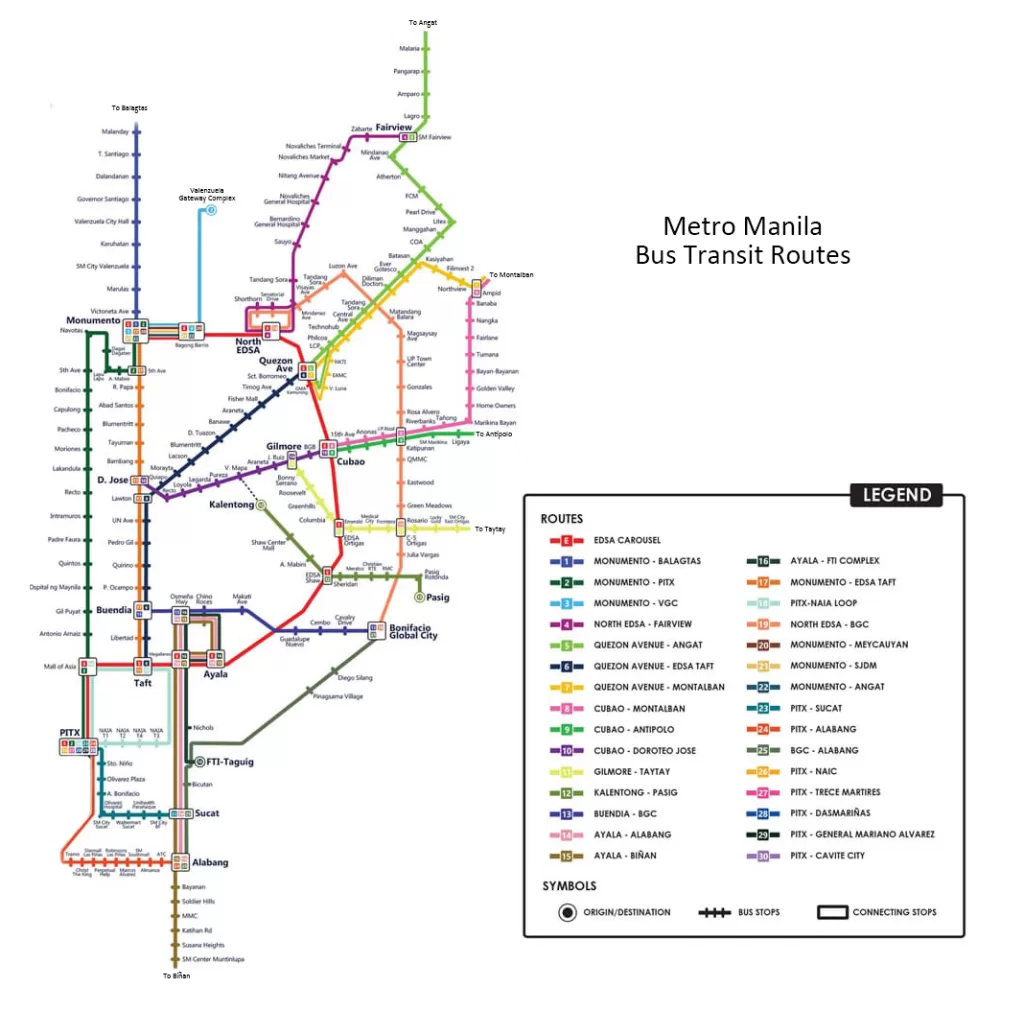
Jeepneys
Jeepneys, more commonly known as jeeps, are a traditional public utility vehicle in the Philippines known for their kitsch decoration, crowded seating, and open rear door design.

Just like buses, they follow a fixed route with specific end terminals. The only difference is that they do not have designated stations. Hence, you can alight or get on the jeepney anywhere along its route, as long as the area is not tagged as a no-boarding zone. To board the jeepney, raise your hand to signal the driver that you want to ride. To alight, you have to shout “Para!”
As of November 2022, the minimum fare for traditional jeepneys is ₱12 for the first four kilometers plus ₱1.80 for every succeeding kilometer. On the other hand, the minimum fare for modern or electric jeepneys is ₱14 for the first four kilometers plus P2.20 for every succeeding kilometer.
Public Utility Vans
Public utility vans, more commonly known as UV Express or FX, are white vans that have been repurposed to operate as utility vehicles. They operate much like jeepneys— with fixed-end terminals and no designated stations. The only difference is that they’re airconditioned. Don’t get your hopes up though. Some of these vans are poorly maintained, and sometimes they are even more uncomfortable to ride than jeepneys.

Unfortunately, some UV Express operators and drivers do not follow the rules on minimum fare. The fare greatly depends on the route and ranges from ₱15 to more than ₱60. Nevertheless, they are a good option for passengers who prefer vans over jeepneys.
Taxis
Taxis are a great option for passengers who are carrying heavy luggage or are traveling in groups. They are available almost everywhere in Metro Manila.
There are three types of taxis: regular, airport-metered, and coupon taxis. Regular taxis are white sedans that charge the regular flagdown rate of ₱45 plus ₱2 for every succeeding kilometer. They are the most common type of taxi in Manila.
Airport-metered taxis are yellow sedans that charge almost double the regular taxi rate. They are typically in better condition and are the only metered taxis allowed on the airport premises. Their flag-down rate is ₱70 plus ₱4 for every succeeding 300 meters.
Coupon taxis are blue-marked white sedans, available at the airport, that charge a fixed rate depending on the destination. To ride a coupon taxi, proceed to their dispatch station located across the Arrival Hall Exit and state your destination. The staff will give you a coupon indicating the fixed price to pay upon arrival.
Be wary when riding a taxi. Even though most drivers are friendly, some scammers take advantage of tourists and passengers from the provinces who are not familiar with Manila. If you have internet access, use Google Maps or Waze to make sure that you’re going the right way. Also, if you’re riding a metered taxi, always ask to turn on the taximeter. Some drivers charge much higher than normal so do not agree to pay a flat rate.
Ride-Hailing Services
There are four major app-based Transport Network Vehicle Services or TNVS currently operating in Metro Manila: Grab, Angkas, Joyride, and Move It. Grab offers GrabCar (a car-hailing service) and GrabTaxi (a taxi-hailing service), while Angkas, Joyride, and Move It are motorcycle-hailing services.
These ride-hailing services are more expensive than taxis. However, since booking is done online, they are far more convenient. In general, GrabCar charges the highest rates, followed by GrabTaxi, and then Angkas and Joyride.
As of writing, GrabCar’s base fare is between ₱40 to ₱50 with an additional ₱15 to ₱18 per succeeding kilometer. Meanwhile, GrabTaxi’s base fare is ₱40 with an additional ₱13.50 per succeeding kilometer. Angkas and Joyride offer the lowest rates with a base fare of ₱50 with an additional ₱10 per succeeding kilometer. All of these rates vary depending on the demand surge and available promos.
Tips when commuting in Metro Manila
Manila’s public transportation still has a lot of room for improvement. However, if you know the basics, then commuting can be easy. Here are some tips and things to remember when commuting in Metro Manila:
- Always bring small bills and coins. Even though e-wallets are already starting to gain traction, the majority of the country’s transactions are still done via cash. Always carry small bills and coins to save you the hassle of asking for change.
- Wear comfortable and light clothes. The Philippines is a tropical country so the weather is generally hot and humid. It is normal to sweat a lot when commuting.
- Do not wear expensive jewelry and avoid using phones in public. Unfortunately, snatchers are still rampant in Manila. Always be wary of your belongings when commuting.
- When riding a jeepney, you may encounter beggars or street children getting on the jeep and asking for money. The government discourages commuters from giving money, however, it’s totally up to you if you want to share your blessings.
- Be ready to take long walks. As we’ve mentioned earlier, Metro Manila’s development is very much car-centric. Going to the bus and train stations alone requires great stamina and patience.
- Avoid commuting during rush hour. This normally happens from 7 AM to 9 AM and from 5 PM to 8 PM on weekdays.
- When riding a bus, you may encounter missionaries getting on the bus to spread the word of god, students selling food items, or people asking for donations.
- Do not hesitate to ask for directions. Fortunately, most Filipinos have a fair command of English. As a hospitable country, I’m sure most of us will be happy to help.
Commuting can be fun if you know how the Philippine public transportation system works. We hope this article helped you get a better idea of how to navigate Metro Manila on your own! If you have any further questions, do not hesitate to comment below. We’ll try to answer as soon as we can.
Ron Lao is an engineering graduate with a passion for writing informative content and exploring new places, cultures, and food. He loves science, cats, badminton, and anything wellness-related.




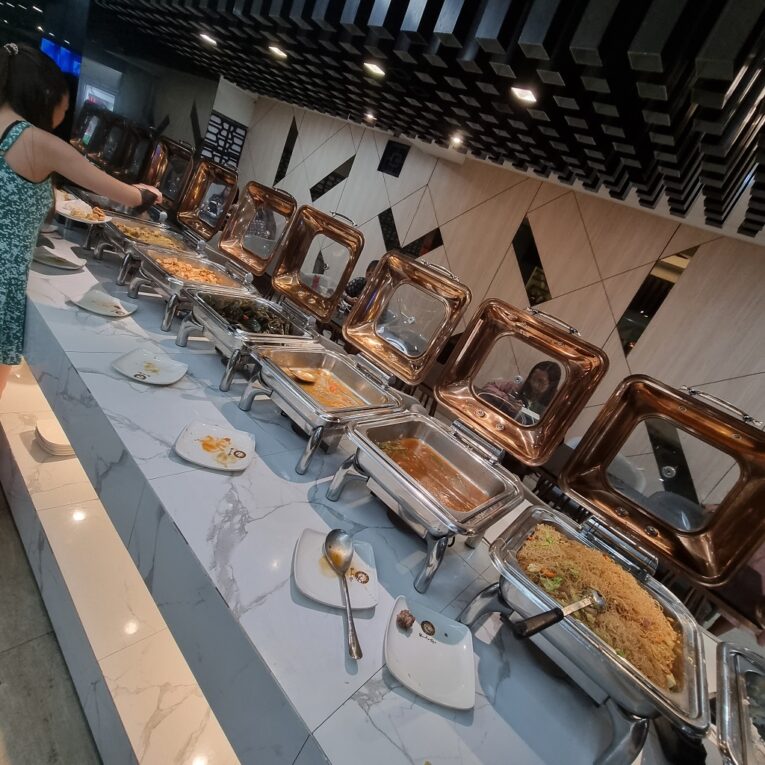
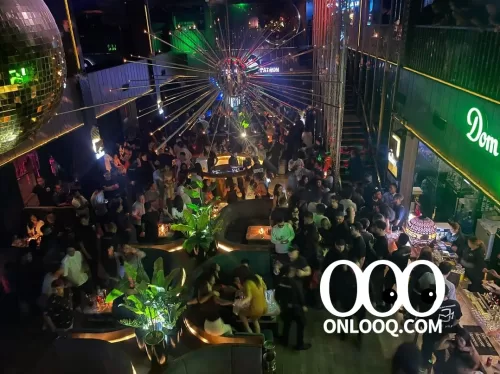
Leave a Reply